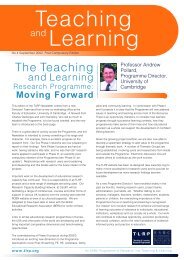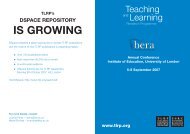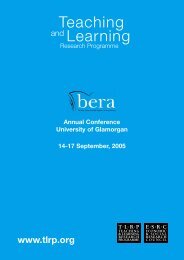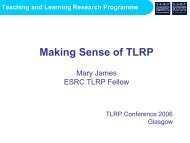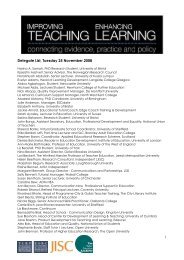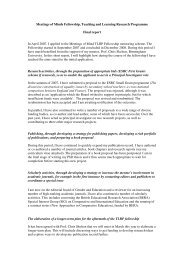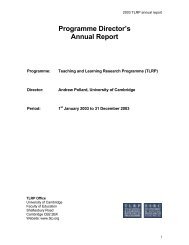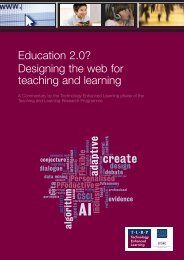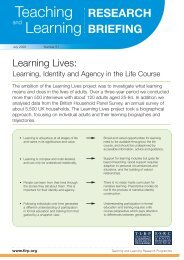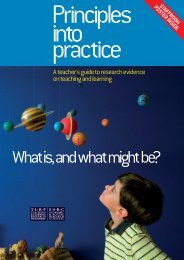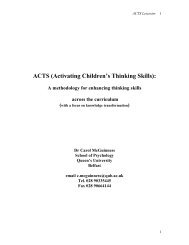The Socio Cultural and Learning Experiences of Working Class ...
The Socio Cultural and Learning Experiences of Working Class ...
The Socio Cultural and Learning Experiences of Working Class ...
You also want an ePaper? Increase the reach of your titles
YUMPU automatically turns print PDFs into web optimized ePapers that Google loves.
<strong>The</strong> research<br />
Aims<br />
To explore working class students’<br />
experiences <strong>of</strong> higher education <strong>and</strong> their<br />
impact on students’ learner <strong>and</strong> cultural<br />
identities<br />
To compare <strong>and</strong> contrast the social <strong>and</strong><br />
cultural experiences <strong>of</strong> working class<br />
students in different types <strong>of</strong> higher<br />
education institution, <strong>and</strong> the extent to<br />
which these experiences are gendered<br />
<strong>and</strong> where relevant ‘raced’.<br />
To examine the impact <strong>of</strong> the experience<br />
<strong>of</strong> university on the construction <strong>and</strong> reconstruction<br />
<strong>of</strong> the students’ identities,<br />
<strong>and</strong> to explore the processes <strong>of</strong> compliance<br />
or resistance which students adopt to<br />
position themselves as effective learners.<br />
To contribute to the theoretical<br />
underst<strong>and</strong>ing <strong>of</strong> social class <strong>and</strong> learner<br />
identities within the higher education context.<br />
<strong>Working</strong> class<br />
students’ experiences<br />
<strong>of</strong> higher education:<br />
the students <strong>and</strong><br />
institutions<br />
This research was carried out in the context<br />
<strong>of</strong> a polarised system <strong>of</strong> mass higher<br />
education, with working class <strong>and</strong> mature<br />
students attending post-1992 universities in<br />
greater numbers.<br />
<strong>The</strong> four higher education institutions (HEIs)<br />
in our study comprise a post 1992 university,<br />
Northern; a civic pre-1992 university,<br />
Midl<strong>and</strong>, an elite university, Southern <strong>and</strong> a<br />
college <strong>of</strong> further education where the<br />
students undertake Foundation degrees in<br />
conjunction with Northern, which we term<br />
Eastern College. All are very different in terms<br />
<strong>of</strong> wealth, mission <strong>and</strong> admissions policies,<br />
as well as in location. <strong>The</strong>se factors impact<br />
on the students’ socio-cultural <strong>and</strong> learning<br />
experiences in a range <strong>of</strong> ways.<br />
<strong>The</strong> working class student participants at<br />
the four institutions differed in terms <strong>of</strong> age,<br />
gender, ethnicity, qualifications, domestic<br />
responsibilities <strong>and</strong> finance. <strong>The</strong> middle class<br />
students at all the universities had more<br />
knowledge <strong>of</strong> <strong>and</strong> preparation for university<br />
life <strong>and</strong> what to expect <strong>of</strong> it than did the<br />
working class students. Many middle class<br />
students expressed a strong sense <strong>of</strong><br />
entitlement about going to university,<br />
frequently engendered by their families <strong>and</strong><br />
schools. For the working class students,<br />
attendance at university at all was <strong>of</strong>ten by<br />
luck rather than planning, <strong>and</strong> even for the<br />
Southern working class students it was <strong>of</strong>ten<br />
surprisingly serendipitous.<br />
Students’ qualifications, their route to<br />
university <strong>and</strong> their school experiences are<br />
key aspects <strong>of</strong> the formation <strong>of</strong> their learner<br />
identity. A key difference between students at<br />
Southern <strong>and</strong> those at Midl<strong>and</strong> <strong>and</strong> Northern<br />
is the self-confidence that Southern students<br />
have about themselves as successful<br />
learners <strong>and</strong> high achievers. This is matched<br />
by a level <strong>of</strong> self -assuredness among middle<br />
class students at all three universities.<br />
By contrast, a number <strong>of</strong> the students at<br />
Northern express a lack <strong>of</strong> self-confidence<br />
<strong>and</strong> a sense that they are unworthy to be<br />
at university at all. Students at Northern<br />
<strong>of</strong>ten hold academic qualifications which are<br />
tenuous in relation to the dem<strong>and</strong>s <strong>of</strong> their<br />
degree courses. Fewer A level points are<br />
required to win a place. Eastern College<br />
students tend not to identify as university<br />
students <strong>and</strong> did not identify with Northern<br />
University, which validated their Foundation<br />
degree.<br />
Institutional Effect <strong>and</strong><br />
Learner Identities<br />
Our data suggest that an ‘institutional effect’<br />
or institutional habitus (Reay et al 2005) is a<br />
variable by which class processes are played<br />
out in the higher education experiences <strong>of</strong><br />
students. <strong>The</strong> universities <strong>and</strong> college in our<br />
study have institutional habituses which link<br />
their organisational culture <strong>and</strong> ethos to<br />
wider socio-economic <strong>and</strong> educational<br />
cultures. This means that there are greater<br />
differences between student experiences<br />
at different universities than between the<br />
experiences <strong>of</strong> students from different<br />
backgrounds in each university. Of course,<br />
this is not to say that the working class<br />
students in the respective universities had<br />
the same experiences as their middle class<br />
counterparts.<br />
Expectations <strong>of</strong> programmes <strong>and</strong> their<br />
delivery differ between HEIs <strong>and</strong> subjects.<br />
Students at Southern University have to<br />
live on campus <strong>and</strong> are forbidden to take<br />
jobs during term time. Most are young<br />
students from school <strong>and</strong> without family<br />
commitments, making their term work<br />
hard <strong>and</strong> intensely focussed, with thorough<br />
immersion in their subject <strong>and</strong> in academic<br />
culture.<br />
Southern University’s College system creates<br />
the conditions for strong identification.<br />
Students live <strong>and</strong> eat in College, which<br />
provides a personalised student support<br />
network. A range <strong>of</strong> competitive relationships<br />
are devised to raise the students’<br />
commitment to both College <strong>and</strong> University<br />
life, with wealthy Colleges able to provide<br />
their students with bursaries.<br />
By contrast, most students at Northern<br />
University (70 per cent <strong>of</strong> our questionnaire<br />
responses) <strong>and</strong> Eastern College (all those<br />
interviewed <strong>and</strong> who responded to the<br />
questionnaire) live at home. Northern<br />
students work part-time, between 10 <strong>and</strong> 20<br />
hours per week. Most Midl<strong>and</strong> students lived<br />
in halls or student accommodation in town.<br />
Only two respondents (both working class)<br />
lived at home. A minority had part-time<br />
weekend work. At Northern <strong>and</strong> Midl<strong>and</strong><br />
students attend lectures, although these are<br />
not compulsory, <strong>and</strong> seminars <strong>and</strong> lab work<br />
for the sciences. At Northern there is little<br />
tutorial time unless the student seeks it out.<br />
By contrast, at Southern University <strong>and</strong> to<br />
a lesser extent Midl<strong>and</strong>, there were regular<br />
small-group tutorials where the expectation<br />
was that students made substantial<br />
contributions, <strong>and</strong> were challenged <strong>and</strong><br />
questioned by both their peers <strong>and</strong> teachers.<br />
Even if they wanted to, they could not remain<br />
passive learners.<br />
At Northern a system <strong>of</strong> on-line learning was<br />
being developed to encourage students to<br />
access lecture notes, module guides <strong>and</strong><br />
learning materials remotely, avoiding the<br />
need for university attendance. Although<br />
students said that their tutors were helpful<br />
<strong>and</strong> approachable, it was incumbent on<br />
the individual student to take the initiative.<br />
Northern students demonstrated more<br />
evidence <strong>of</strong> fragile learner identities,<br />
displaying anxiety <strong>and</strong> a lack <strong>of</strong> confidence<br />
in their own abilities. <strong>The</strong>y expressed the<br />
need for more opportunities to discuss ideas<br />
with their tutors, but, paradoxically, were<br />
encouraged to work on their own or interact<br />
via the web. At Midl<strong>and</strong> the structured<br />
support was similar although more module<br />
<strong>and</strong> personal tutor contact seemed to be<br />
available.<br />
<strong>The</strong> key difference between these two<br />
universities <strong>and</strong> Southern is the way in which<br />
they provide support generically rather than<br />
targeting it at the individual student. Once a<br />
student is accepted into Southern, resources<br />
are targeted to ensure individual success for<br />
all. Students receive detailed feedback each<br />
term on how they are progressing in relation<br />
to their degree classification.<br />
<strong>The</strong> socio-cultural<br />
experiences <strong>of</strong><br />
working class<br />
students<br />
<strong>The</strong> social field <strong>of</strong> the university <strong>of</strong>fered<br />
opportunities for enhancing or compensating<br />
for students’ habitus <strong>and</strong> for the acquisition<br />
<strong>of</strong> social <strong>and</strong> cultural capital. At Southern<br />
the social opportunities were wide-ranging.<br />
<strong>Working</strong> class students were either daunted<br />
by these options or, in their first year<br />
especially, were anxious about managing<br />
their time effectively <strong>and</strong> keeping on top <strong>of</strong><br />
their very dem<strong>and</strong>ing workloads. <strong>The</strong> social<br />
life at Midl<strong>and</strong> was a central part <strong>of</strong> the<br />
university experience. <strong>The</strong> students’ union<br />
was the hub <strong>and</strong> provided extensive society<br />
<strong>and</strong> sporting opportunities. <strong>The</strong> halls <strong>of</strong><br />
residence, structured through a village type<br />
<strong>of</strong> organisation, provided the social field<br />
through which students were enabled to<br />
make friends <strong>and</strong> to associate with a diverse<br />
set <strong>of</strong> people from different social classes,<br />
ethnicities <strong>and</strong> subject areas.<br />
At Northern the social facilities were limited<br />
<strong>and</strong> our case study students used them<br />
rarely if at all. Two reasons accounted for<br />
this. As they lived <strong>of</strong>f campus, they went<br />
www.tlrp.org<br />
Teaching <strong>and</strong> <strong>Learning</strong> Research Programme



